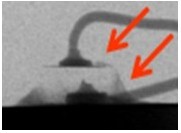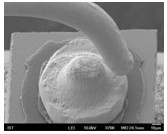The LED light source is composed of the so-called III-V compound, which is a well-known epitaxial chip. The solid compound itself is very stable in nature, and it is not easy to damage under the conditions specified by the product. In the application environment, there is no chemical reaction, so it has a long product life. However, in order to make the LED chip emit light, current must be passed from the outside, so the chip with a small size is generally pasted on a specific carrier (or lead frame) and connected to the chip with metal wire or solder. The positive and negative poles, and then use polymer materials to cover the entire stage, this is the so-called packaging process, after this process becomes a common LED lamp on the market. In actual application, several LED lights will be assembled into modules as needed, and finally combined with other functional modules to become a terminal product.
It can be seen from the above that the cause of failure of an LED product may come from any part of the product, so it is necessary to extract the cocoon to find the true cause of failure. For the failure comes from the LED lamp particles, the LED chip itself is very strong in the complete LED lamp particles, but the packaging material covering the chip is vulnerable to damage. Therefore, the failure of the LED lamp particles can be attributed to the packaging material. Caused by destruction or deterioration. To fully analyze such failures, it involves professional knowledge in the fields of optics, chemistry, materials science, electronic physics, etc., combined with sophisticated instruments and rich practical experience, in order to confirm the failure point and deduce the true cause, and then propose improvement measures .
1. Off: This kind of failure means that the LED does not emit light at all after being powered on. Generally speaking, the "open" on the conductive path is one of the main causes of this type of failure. The method of confirming the open circuit is also very simple, which can be verified by a common three-meter meter. However, to find the break point, further analysis must be done, for example: X-ray can be used to confirm whether the wire is broken or detached, SEM (scanning electron microscope) can be used to observe the cross-sectional structure, and the defects of the sticky crystal can be checked. Wait. The second main cause of this type of failure is "short", because the current does not actually pass through the LED chip, but flows through the "side door left", so the LED lamp particles will not naturally emit light, such as: due to the occurrence of electron migration Abnormal diffusion of electrode metal atoms, such as indium tin oxide (ITO), silver, or barrier metal in GaN / InGaN diodes, can cause such anomalies due to mechanical stress, high current density, or in a corrosive environment. Other reasons may be the deviation of the bonding wire, the glue sticky glue and so on. This failure must be determined by IV curve (current-voltage diagram). As for the failure point, the above defects cannot be detected from the appearance, so it needs to be confirmed by X-ray; or after removing the LED packaging material by chemical solution, then use Check carefully with an optical (OM) or electron microscope (SEM).

Short circuit creep

Open circuit
2. Discoloration: This type of failure means that when the LED is not lit, the appearance color or the transparency of the glue material is different from the new product. It can be seen with the naked eye, and usually occurs after the product has been used for a period of time or after the reliability test has been completed. Generally speaking, the discolored area can be roughly divided into two types: lead frame or encapsulant. If it occurs in the lead frame, it is usually because the surface reacts with chemical substances in the environment, such as oxidation or sulfurization. Depending on component analysis, the available instruments include EDS (Energy Dispersive X-ray Spectroscope), XPS (X-ray Photoelectron Spectrometer), AES (Augur Electron Spectroscope), etc. If the plastic material used for encapsulation is discolored, it is a degradation phenomenon of polymer materials. For example, epoxy resin is easily affected by high temperature or ultraviolet light and turns yellow. Therefore, white LEDs are replaced by silicone rubber. Special attention should be paid to the analysis of such failures, because the plastic material itself has a certain transparency, and sometimes the discolored lead frame is covered by the plastic material and is mistaken for the plastic material to change color, leading to the wrong direction of improvement.

Discoloration of the bracket
3. Light attenuation: This failure means that the light intensity emitted by the LED is lower than that of the new product. As mentioned in the previous chapter, the degree of light attenuation has become an important indicator for judging the life of LED lighting products, so the analysis of such failures is very important. Overall, the analysis of this type of failure is very complicated, because there are many factors that affect the light intensity, such as chip degradation, reflective cup degradation, delamination between the adhesive and the chip, the transparency of the adhesive decreases, the resistance of the wire bonding surface increases, The thermal resistance is too high, etc. If it occurs in white LEDs, it is also necessary to consider the problem of phosphor degradation. Because white LEDs usually use one or more phosphors, they will be attenuated and reduced by the influence of heat or moisture. Efficiency, resulting in changes in the light color of the output. The analysis methods include: non-destructive detection, such as visual inspection, LED electrical curve, optical characteristics of integrating sphere, etc., use the above data to comprehensively judge and exclude one by one, and after deducing the possible causes, then conduct destructive analysis and use samples The preparation technology produces suitable analysis samples, which are supplemented by various instruments such as SAT (Scanning AcousTIc Tomography) ultrasonic scanning, FTIR (Fourier Transform InfraRed) Fourier transform infrared spectrometer, TEM (Transmission Electron Microscope) transmission electron microscope, SEM (Scanning Electron Microscope) and so on to be verified, to get to the real cause.

White light LED light attenuation analysis-yellow light intensity attenuation
Sport In-ear Bluetooth Headset
Creative Sports Earphones,Wireless Sport Earbuds,Bluetooth Sports Earbuds,Best Wireless Earbuds For Running
Dongguang Vowsound Electronics Co., Ltd. , https://www.vowsound.com